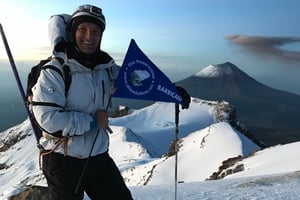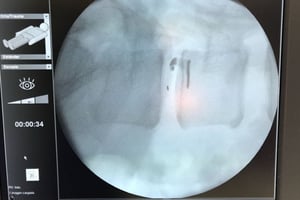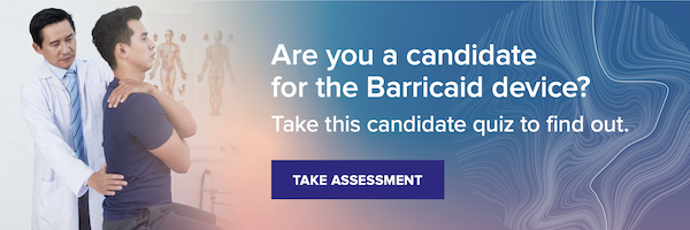
Meet Diego, a dedicated athlete who spends his days mountain climbing, running, and maintaining an active and healthy lifestyle.
Athleticism is in Diego’s blood, a trait in his family for as long as he can remember. His grandfather was recognized as the best athlete in Mexico for three years in a row and earned a medal after competing in the pentathlon at the Pan American Games.
Unfortunately, Diego’s training routine came to a crashing halt after two injuries—one in 2006 and another in 2017—leaving him with debilitating pain in his lower back, leg, and foot. Although the 2006 accident resulted in a lumbar herniated disc, the injury healed nicely on its own, likely in large part due to Diego’s healthy lifestyle and behaviors.
Fast forward to 2017, when Diego was riding in the back of an Uber car. As the driver slowed down for a large speed bump, a car crashed into the back of the Uber at 40 miles an hour. Sadly, the result for Diego was an immediate ‘snap’ in his lumbar spine, leading to severe reinjury, with a reherniated disc and the recurrence of painful symptoms to show for it.
After his second accident, Diego knew he needed help—especially because the 2017 injury wasn’t healing naturally, the way the first herniation had. With that said, Diego wondered what his future would look like. If he had surgery, would he ever play sports and exercise the same way again?
Researching Surgical Treatment Options
Diego began researching his options, visiting not one, not two, not three, but four spine surgeons before he made his decision. Each surgeon, both in Mexico and the U.S., recommended a spinal fusion with screws and plates, which would inevitably cause Diego to lose some of his spine mobility and may put a return to athleticism at risk.
For Diego, like many other injured athletes, that simply wasn’t an option. That’s why he didn’t give up or just accept the first medical recommendation he received.
Instead, he kept researching the treatment options available to find the one best suited to his needs. This approach is simply in Diego’s nature; whether he’s shopping for a medical device or a mountain climbing bag, he does his research before making a purchase, to ensure he finds the best product available. The fact that Diego is an experienced medical entrepreneur further contributed to a thorough investigation of treatment options.
Finally, through professional connections, Diego met with one of the leading orthopedic surgeons in Mexico, who led the practice in the Navy hospital there. After seeing a model of the Barricaid device in his healthcare partner’s office, Diego began to ask questions due to his natural curiosity. He was then connected with a local Barricaid distributor, and after learning more about the innovative technology, he asked to be placed in contact with a surgeon who offers this treatment option. Immediately following his doctor consultation, Diego decided to move forward with a lumbar discectomy with Barricaid.
Surgery with Barricaid (and Beyond)
After his surgery, which he had two-and-a-half months after his disabling 2017 accident, Diego was up and walking the very next day—and even walking several miles within a week.
 Following a quick recovery period, Diego vowed to get back to doing what he loves most: “As soon as I get better, I will put the Barricaid flag at the highest
Following a quick recovery period, Diego vowed to get back to doing what he loves most: “As soon as I get better, I will put the Barricaid flag at the highest
point in Mexico. Five months later, I climbed and put the flag on a 5,200 meter/17,000 foot mountain.” It was an emotional moment for Diego, and a recovery milestone, when he did just that.
Today, Diego is pain-free and maintains the active lifestyle he has always loved. He runs 3-4 times a week for approximately six miles at a time. He often climbs mountains, both large and small, with a 60-pound pack on his back. Exercise has been key when it comes to recovering and sustaining a healthy, pain-free back.
In Diego’s own words, “To me, coming back to sports was a must. My spirit would have died if I didn’t come back to my normal life, and Barricaid was without a doubt the element that gave me the ability to come back to what I love.”
Now living an identical life to the one before the accident that caused him debilitating pain, Diego is incredibly thankful he found the technology when he did. “For someone who wants to stay active, Barricaid is the choice,” Diego said. “While climbing, the last thing on my mind—even with a 60-pound backpack—is any concern about a reherniation or return of back pain”.
Staying active was the only fathomable option for Diego, and now with the Barricaid device to help minimize the risk of reinjury, he can keep climbing those mountains—and never looking back!
While this blog is meant to provide you with information you need to make an informed decision about your treatment options, it is not intended to replace professional medical care or provide medical advice. If you have any questions about the Barricaid, please call or see your doctor, who is the only one qualified to diagnose and treat your spinal condition. As with any surgical procedure, you should select a doctor who is experienced in performing the specific surgery that you are considering.
If you have any questions about the Barricaid, you may ask your doctor. For additional information, please visit www.barricaid.com. For complete risk-benefit information: www.barricaid.com/instructions
The patient testimonial provided represents the experience of the particular individual and is not intended to be a recommendation, referral, or prescription for any device or procedure. Intrinsic Therapeutics does not warrant that any of the statements are accurate, complete, or will apply to any particular individual's circumstances.
Whether you can benefit from treatment with Barricaid will depend on your spinal conditions and other physiological factors. Individual results may vary. Only a spine surgeon can decide if the Barricaid implant is right for you. For more information, consult your doctor.



Comments